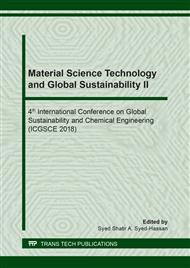[1]
S.N. Beevi, S.M. Seema, Agarwood: fragrance exclusive, Kerala Calling. 49 (2009) 42-43.
Google Scholar
[2]
M.A. Nor Azah, S. Saidatul Husni, J. Mailina, L. Sahrim, J. Abdul Majid, Z. Mohd Faridz, Classification of agarwood (gaharu) by resin content, J. Trop. For. Sci. 25 (2013) 213-219.
DOI: 10.1088/1757-899x/368/1/012023
Google Scholar
[3]
M.H. Qin, Q.H. Xu, Z.Y. Shao, Y. Gao, Y.J. Fu, X.M. Lu, P.J. Goa, B. Holmbom, Effect of bio-treatment on the lipophilic and hydrophilic extractives of wheat straw, Bioresour. Technol. 100 (2009) 3082-3087.
DOI: 10.1016/j.biortech.2009.01.055
Google Scholar
[4]
N. Yoswathana, M.N. Eshiaghi, K. Jaturapornpanich, Enhancement of essential oil from agarwood by subcritical water extraction and pretreatment on hydrodistillation, Int. J. Mol. Sci. 6 (2012) 453-459.
Google Scholar
[5]
N. Sulaiman, M. Ida Idayu, A.Z. Ramlan, M. Nur Fashya, A.N. Nor Farahiyah, J. Mailina, M.A. Nor Azah. Effects of extraction methods on yield and chemical compounds gaharu (Aquilaria malaccensis), J. Trop. For. Sci. 27 (2015), 413-419.
DOI: 10.1016/j.bcab.2019.101066
Google Scholar
[6]
M.N.I. Bhuiyan, J. Begum, M.N.H. Bhuiyan. Analysis of essential oil of eaglewood tree (Aqulilaria agallocha Roxb) by gas chromatography mass spectrometry, Bangladesh J. Pharmacol. 4 (2009) 24-28.
DOI: 10.3329/bjp.v4i1.851
Google Scholar
[7]
P. Wetwitayaklung, N. Thavanapong, J. Charoenteeraboon. Chemical constituents and antimicrobial activity of essential oil and extract of heartwood of Aquilaria crassna obtained from water distillation and supercritical fluid carbon dioxide extraction, Silpakorn U. Science & Tech. J. 3 (2009) 25–33.
DOI: 10.1080/10412905.2010.9700268
Google Scholar
[8]
M.Y. Nor Atikah, T. Saiful Nizam, H. Anwaruddin, M.O. Nor Adila. Agarwood essential oil: study on optimum parameter and chemical compounds of hydrodistillation extraction, J. Appl. Sci. & Agric. 10 (2015) 1–5.
Google Scholar
[9]
P. Jutarut, C. Pakamas, T. Chakrit. Mathematical modeling for extraction of essential oil from Aquilaria crassna by hydrodistillation and quality of agarwood oil, Bangladesh J. Pharmacol. 6 (2011) 18-24.
DOI: 10.3329/bjp.v6i1.7902
Google Scholar
[10]
N. Sulaiman, M. Ida Idayu, A.N. Nor Farahiyah, A. Nor Rashidah, Y. Maizatulakmal. solvent and duration effects on the extraction of oleoresin and oil from gaharu powder (Aquilaria malaccensis), Proceedings of the 1st International Postgraduate Symposium in Biotechnology, Johor Bahru, Johor, Malaysia, 2017 pp.107-111.
DOI: 10.1016/j.bcab.2019.101066
Google Scholar
[11]
M.A. Nor Azah, Y.S. Chang, J. Mailina, A. Abu Said, J. Abd. Majid, S. Saidatul Husni, H. Nor Hasnida, Y. Nik Yasmin. Comparison of chemical profile of selected gaharu oils from Peninsular Malaysia, Malaysian J. Anal. Sci. 12 (2008) 338-340.
DOI: 10.1088/1757-899x/368/1/012023
Google Scholar
[12]
H. Chen, Y. Yang, J. Xue, Z. Zhang, H. Chen. Comparison of compositions and antimicrobial activities of essential oils from chemically stimulated agarwood, wild agarwood and healthy Aquilaria sinensis (lour.) gilg trees, Molecules. 16 (2011) 4884–4896.
DOI: 10.3390/molecules16064884
Google Scholar
[13]
AOAC, Official Method of Analysis. Gaithersburg, 15th ed. MD, USA, Association of Official Analytical Chemists, Arlington, VA. (1990).
Google Scholar
[14]
A. Sluiter, B. Hames, D. Hyman, C. Payne, R. Ruiz, C. Scarlata, J. Sluiter, D. Templeton, J. Wolfe, Determination of total solids in biomass and total dissolved solids in liquid process samples, in: Technical Report of National Renewable Energy Laboratory (2008).
Google Scholar
[15]
T. Gutfinger, Polyphenols in olive oils, J. Am. Oil. Chem. Soc. 58 (1981) 966-968.
DOI: 10.1007/bf02659771
Google Scholar
[16]
Z. Ahmad, R. Hasham, N.F. Aman Nor, M.R. Sarmidi, Physico-chemical and antioxidant analysis of virgin coconut oil using West African tall variety, J. Adv. Res. Mater. Sci. 13 (2015) 1-10.
Google Scholar
[17]
R. Kadir, M.D. Hale, Antioxidant potential and content of phenolic compound in extracts of twelve selected Malaysian commercial wood species, Eur. J. Wood Prod. 75 (2017) 615-622.
DOI: 10.1007/s00107-016-1095-1
Google Scholar
[18]
K. Chigayo, P.E.L. Mojapelo, S. Mnyakeni-Moleele, J.M. Misihairabgwi, Phytochemical and antioxidant properties of different solvent extracts of Kirkia wilmsii tubers, Asia Pac. J. Trop. Biomed. 6 (2016) 1037-1043.
DOI: 10.1016/j.apjtb.2016.10.004
Google Scholar
[19]
Brookfield LVDV-11+Pro Viscometer: Operating instructions manual M03-165-E0211, in: Brookfield Engineering Labs, Inc., Middleboro, MA, 2012, pp.24-25.
Google Scholar
[20]
J. Mailina, M.A. Nor Azah, J. Fadzureena, P. Mazura, S. Saidatul Husni, J. Abdul Majid, N.Y. Nik Yasmin, Z. Mohd Faridz, M. Ahmad Abdul Qayyum, Identification of volatile constituents from fresh sample of Baeckea fruitescens L. and their distilled oils, in: Mastura M., Adiana MA, Hada Masayu, I. & Pin Ky (Eds), Harnessing The Tropical Herbal Heritage: Recent Advances in R&D and Commercialisation Proceeding of the Seminar on Medicinal and Aromatic Plant, FRIM Kepong, Selangor, Malaysia, 2010, pp.41-45.
Google Scholar
[21]
P. Raksakantong, S. Siriamornpun, N. Meeso, Effect of drying methods on volatile compounds, fatty acids and antioxidant property of Thai kaffir lime (Citrus hystrix D.C.), Int. J. Food Sci. Technol. 47 (2012) 603-612.
DOI: 10.1111/j.1365-2621.2011.02883.x
Google Scholar
[22]
E. Novriyanti, E. Santosa, W. Syafii, M. Turjaman, I.R. Sitepu, Antifungal activity of wood extract of Aquilaria crassna Pierre ex Lecomte against Agarwood-inducing fungi, Fusriumsolani, Indo. J. Forest. Res. 7 (2010) 155-165.
DOI: 10.20886/ijfr.2010.7.2.155-165
Google Scholar
[23]
L. Xu, L.L. Diosady, Removal of phenolic compounds for the production of high-quality canola protein isolates, Food Res. Int. 35 (2002) 23-30.
DOI: 10.1016/s0963-9969(00)00159-9
Google Scholar
[24]
P. Hemali, C. Sumitra, Evaluation of antioxidant efficacy of different fractions of Tagetes erecta L. Flowers, IOSR J. Pharm. Biol. Sci. 9 (2014) 28-37.
DOI: 10.9790/3008-09512837
Google Scholar


